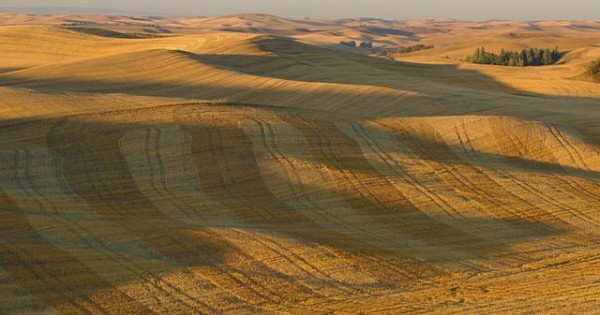
We all dream. Our brain dreams. We dream in Rapid Eye Movement (REM) sleep five to seven times a night, and we dream during non-REM sleep. We dream whether or not we remember our dreams. And we dream all night long.
The brain, it seems, needs to dream. The dreaming brain cannot see what’s out there (the primary visual cortex is shut down), but the visual association areas are wide awake and going wild. The dreaming brain cannot make the body move. It cannot reason or plan or make sense. But it remembers and sifts and learns. We are, said Prospero, “such stuff as dreams are made on.”
Here’s a dream: I’m standing in a dirt road looking out over rolling hills of golden wheat. This is the Palouse, the wheat-growing region of southeastern Washington State. The wheat fields of the Palouse roll on and on. Far to the north are snow-peaked mountains. Back here on the dirt road I’m acting as tour guide for a small, rather shadowy group. I open my arms wide and proclaim, “Bread!”
This movie likely played during REM sleep since it was vivid in color and fervent in feeling and it contained a little story. (I remember the Palouse, but here the geography is wrong.) REM sleep is likely set off by neurons firing in the brain stem, a discovery made by sleep researcher J. Allan Hobson. During REM dreaming the neurotransmitters serotonin and norepinephrine are out of commission. Instead acetylcholine floods the brain. Dopamine is present, playing its violin. (Dopamine denotes desire.) The pons (in the brain stem), the limbic system (seat of emotion), and especially the anterior cingulate cortex (part of the limbic system) are running at full bore.
We dream in part to learn. Beginning with rats and ending with humans, the connection between learning and dreaming has received considerable scrutiny. In the MIT neuroscience lab of Matthew A. Wilson, a rat was set to learning a maze. As it explored the maze, researchers recorded the firing of individual neurons within its hippocampus—that center of learning and memory. Later, while the rat took a nap, researchers recorded the exact same neurons firing once again. They could even tell where the rat was in its maze-dream. Studies on humans confirm that if you’re burning to learn, better to sleep on it.
We dream to incorporate the experiences of the day into long-term memory. (In this process, non-REM dreams are less vivid and less storylike.) We dream to process feelings, most commonly anxiety. I have a recurring dream. I find myself on a city bus full of passengers. I suddenly realize—to my horror—that I have forgotten to get dressed. I’m wrapped in a bath towel, lost, with no idea where I’m going.
To me both dreams—the Palouse Dream and the Bus Dream—have meaning. (It’s debated whether dreams mean anything at all.) My two dreams each dramatize an existential position. The Palouse Dream is a writer’s dream. How thrilling to be able to explain to some small audience that wheat is the source of bread! The Bus Dream connotes that I’m on a journey, grievously unprepared, destination unknown. That journey would be life.
The dreaming brain has work to do that has nothing to do with meaning. It likely needs a rest from serotonin and norepinephrine. It’s possible that non-REM sleep restores glycogen (a key form of carbohydrate) stores. It’s possible that REM sleep (in which the eyes jerk around) is required to oxygenate the eye’s cornea. It’s possible that acetylcholine stimulates the pons to fire (setting off REM sleep), after which the meaning-making areas of the brain make up stories to explain the commotion.
Dreams help us make art and do science. No wonder, since imagination (like dreaming) works in part by associating unrelated images, memories, ideas.
As to whether dreams mean, well, maybe they don’t. But they do if we think they do. We are, after all, a meaning-making species. Anything we experience is subject to our propensity to make meaning. And that includes our dreams.

